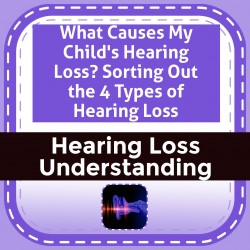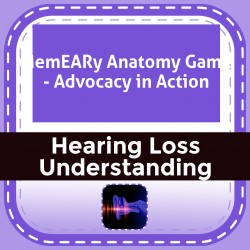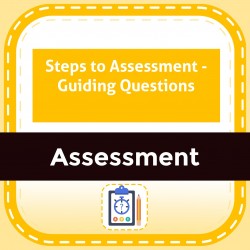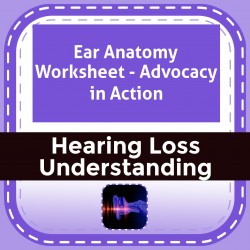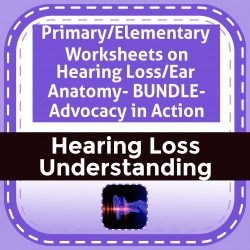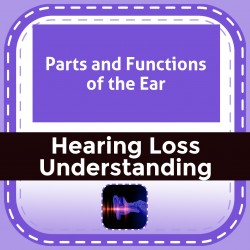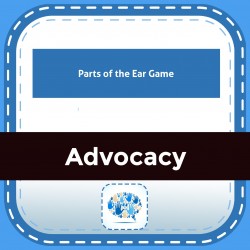Ability Levels
Categories
Resource Types
Age/Grade Range
CCSS
Anchor Standard
Speaking & Listening
Language
Reading
What Causes My Child's Hearing Loss? Sorting Out the 4 Types of Hearing Loss
$ 0
Introductory handout to increase understanding of the different types of hearing loss. A first-timer's simplified explanation.
DHH Social Story: When My Nose Runs
$ 450
Additional Comprehension ActivitiesReading Comprehension QuestionsLists of tier 1 + 2 related vocabGame board to make it fun or help that wiggly off-task child stay focusedNew Concept for Older Kids:
...
What are “endonyms”This is a story to help children/students who wear hearing aids understand why they may go to the doctor and/or ENT more often than others. The story can be read for comprehension. It teaches new vocabulary and creates a wonderful language opportunity for students to better advocate for themselves at school, home, and the doctor/ENT office. This story was written with younger children and their families and older students who continue to come to school with blocked hearing aids and do not use an interpreter for language access.Service Activity for EI-ECSE Families & Home VisitsFor any family this story can be an important conversation starter, or reminder, to understand the language impact of even partially clogged hearing aids for their kid(s) who are not using signs. This can be demonstrated to parents by using a listening tube when their child’s hearing aid is plugged and cleaned and then having them listen again to the difference in clarity of language coming through the hearing aid to their child’s brain.Story Printable OptionPrint each two-page spread in landscape mode OR - Print a two-page spread but cut apart pages to show 1 page at a time. Spiral bind, 3-hole punch, or staple.Interactive Digital OptionPresent the book on a device or overhead projector. To play the digital version of the game click on the digital spinner link. Change the spinner to “3” numbers. Pick & move game pieces (pink, green, blue)QuestionsUse professional judgment when deciding on which comprehension questions to ask the student. *The advanced questions are marked with an * following the number.VocabularyTier 1 vocabulary Tier 2 vocabulary prefix Endonyms short nonfiction passage Endonym Activity Options ask students to research endodyms related to sick words show sick examples and ask them to find more
MemEARy Anatomy Game - Advocacy in Action
$ 150
Cards with ear anatomy parts labeled on each. Second page with ear diagram so cards can be printed double-sided. Print two copies and play the Memory Game or use as flash cards.
Steps to Assessment - Guiding Questions
$ 150
This handout specifies areas of assessment for students with hearing loss and guiding questions to be asked within each area. The questions help teachers and school teams to identify assessment area n
...
eeds to further define specific student needs.
Ear Anatomy Worksheet - Advocacy in Action
$ 150
Worksheet that the student would fill in to label the parts of ear anatomy. Includes a second page with the answer key.
Primary/Elementary Worksheets on Hearing Loss/Ear Anatomy- BUNDLE- Advocacy in Action
$ 195
BUNDLE - Worksheets for primary level instruction on hearing loss, audiograms , and ear anatomy. Worksheets include terms such as frequency, pitch, parts of the ear, anatomy. A game is also included
...
to practice the parts of the ear. Bundle IDs 0513-0519.
Parts of the Ear Boom Cards
$ 5
Knowing the parts of the ear and how we process sound is a great step towards a better understanding of one's own hearing loss. In fact, this skill is often included as an IEP goal for students who ar
...
e deaf/hard of hearing. This deck of Boom Cards features 29 cards in a lesson format that detail the 3 main sections of the ear (outer, middle, and inner), the parts within each section, as well as the function of each part. This deck is perfect for teaching parts of the ear during one-on-one sessions with your deaf/hard of hearing students, or as an independent review.Included throughout the deck are several checkpoints (6 total) for students to demonstrate their understanding with drag-and-drop cards and fill-in-the-blank cards. And because Boom Cards keeps track of students' progress, you can easily collect data towards any IEP goals related to this topic.This product includes:· A link to access 29 Digital Task Cards on Parts of the Ear (1 card per slide) on the BOOM Learning℠ website· Teacher Notes on how to use these BOOM Cards™ in your classroomThese task cards feature lesson cards on:· Outer EarThe pinna, ear canal, eardrumThe function of each partHow sound energy changes form and travels2 self-checking cards· Middle EarThe hammer, anvil, stirrupThe function of each partHow sound energy changes form and travels2 self-checking cards· Inner EarThe cochlea, semicircular canals, vestibule, auditory nerveThe function of each partHow sound energy changes form and travels2 self-checking cardsMore about BOOM Learning…To use Boom Cards, you must be connected to the Internet. Boom Cards play on modern browsers (Chrome, Safari, Firefox, and Edge). Apps are available for Android, iPads, iPhones, and Kindle Fires. For security and privacy, adults must have a Boom Learning account to use and assign Boom Cards. You will be able to assign the Boom Cards you are buying with "Fast Pins," (play provides instant feedback for self-grading Boom Cards). Fast Play is always a free way for students to engage with Boom Cards decks. For additional assignment options, you'll need a premium account. If you are new to Boom Learning, you will be offered a free trial of our premium account. Read here for details: http://bit.ly/BoomTrial.
Parts and Functions of the Ear
$ 0
Diagram to teach the scientific names for parts of the ear. Use this as an activity to help students understand the make up and functions of the parts of the ear.
Parts of the Ear Game
$ 5
This is a fun digital learning activity for a student to review the 3 parts of the ear. The learner identifies the function of each part, what is in each part and uses a diagram to identify parts of t
...
he ear.There are very few digital learning activities available today. Advocacy practice for students with hearing loss includes learning about hearing. As students begin to learn how they ear, identifying the 3 parts of the ear is a first step. They need lots of practice labeling different parts of the ear and identifying how they help with hearing. Learning Objective:1. The student will be able to identify functions of the 3 parts of the ear. 2. Given a diagram, the student will label the part of the ear.
Advocacy - Steps to SA Success Goal 1-Understanding the Science of Hearing
$ 3
Students learn vocabulary around the anatomy of hearing. Students learn their own hearing history and describe their own hearing challenges with this fillable timeline.
 Your browser is out of date. For best experience switch to latest updated Browser.
Your browser is out of date. For best experience switch to latest updated Browser.
 Get Chrome
Get Chrome Get Edge
Get Edge Get Firefox
Get Firefox